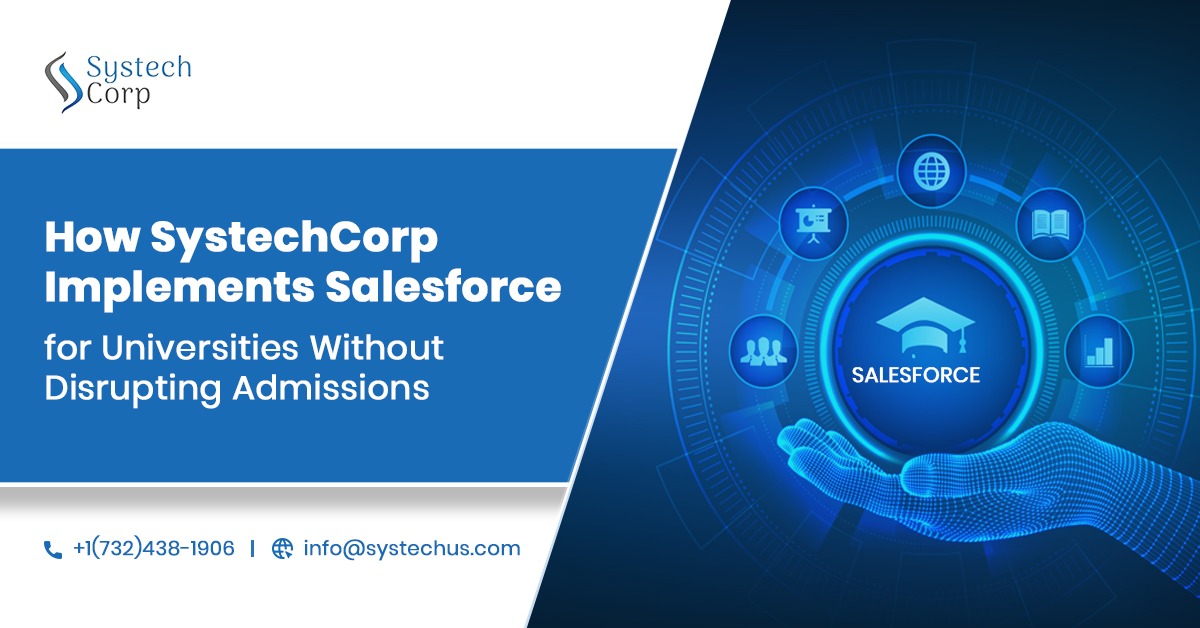In higher education, the admissions process is the heartbeat of every academic year. A large number of students are dependent on swift responses, credible evaluations, and customized communications. Relatively minor system holdups or migration lapses can trigger unforeseen implications-lost applications, compliance errors, or disappointment among students.
Many educational institutions acknowledge Salesforce as a formidable CRM platform, but are unwilling to deploy it during active admissions cycles. The concern is readily apparent: poor timing or inadequate implementation would hold up application processing and negatively affect student educational experiences.
We have developed a Salesforce implementation for universities at SystechCorp that transforms admissions procedures while maintaining business continuity. By using proven integration techniques, phased rollouts, and careful planning, we upgrade without causing any disruption.
Why Traditional CRM Migrations Can Derail Admissions
Universities operate under unique constraints that typical commercial CRM projects don’t face:
- Admissions follow a fixed academic calendar; downtime isn’t an option.
- Data flows span multiple systems: SIS, legacy ERPs, third-party portals, and Banner.
- Regulations like FERPA and GDPR require uncompromising data integrity.
- Applicant experiences must remain seamless even as backend systems change.
Many institutions delay digital transformation because migrating to new platforms mid-cycle can lead to data loss, extended outages, or incomplete integrations. That’s where SystechCorp’s specialized methodology makes the difference.
The SystechCorp Approach: Zero-Disruption Salesforce Implementation
SystechCorp structures every project around a few core principles that prevent disruption during Salesforce implementation for universities. Each principle is intended to preserve operational reliability, protect data integrity, and maintain the admissions teams stay full productive. By incorporating technical expertise with comprehensive planning, we mitigate threats at each point in time.
- Phased & Hybrid Rollouts—Instead of a single, all-at-once migration, we begin using a methodical approach that transitions admissions operations to Salesforce in better-thought-out phases.
- Parallel Operations—Old and new systems run side by side, making sure there are no data or workflow gaps.
- Rigorous Data Integrity & Reconciliation – Nearly every record is confirmed, with rollback mechanisms prepared as well.
- Stakeholder Alignment—Admissions staff, IT teams, and leadership continue to be in harmony with organized collaboration efforts.
- Role-Based Training & Staged Adoption – Users are trained in real-world scenarios before launch.
- Continuous Monitoring – Real-time oversight ensures stable cutovers.
Step-by-Step Salesforce Implementation Journey
Our approach mirrors student recruitment CRM best practices, refined for higher education environments.
1. Discovery & Process Mapping
We analyze existing admissions workflows, data sources, and KPIs. This includes mapping Banner data structures and identifying the best way to integrate SIS with Salesforce-critical for smooth downstream operations.
2. Design & Architecture
Our architects create secure, scalable data models and workflows. We plan the Banner Salesforce integration to ensure admissions data flows seamlessly across student information systems and CRM components.
3. Development & Integration
We configure Salesforce Sales Cloud, Experience Cloud, or Education Cloud for admissions. Integration includes SIS, ERP, and legacy CRMs using APIs and middleware-following the best way to integrate SIS with Salesforce for real-time, bidirectional data sync.
4. Pilot & Parallel Run
Before going live, we launch pilots for a select applicant group or program. Old and new systems run in parallel to verify performance, accuracy, and user adoption.
5. Full Go-Live & Post Launch Stabilization
After successful pilots, admissions fully transitioned to Salesforce. Legacy systems are decommissioned in phases. Our support team monitors the platform intensively to ensure zero disruption.
Key Capabilities Enabled Through Salesforce Implementation
Once Salesforce is live, universities will have highly effective functions that transform admissions speed:
- Unified Applicant 360° View – Every single interaction, document, and decision component in one place.
- Automated Workflows – Eligibility checks, paperwork verification, and follow-ups.
- Tailored Communication – Email, portals, and reminders customized to each student.
- Real-Time Dashboards – Admissions officers and leadership receive insight right away.
- Regulatory Compliance – Built-in security and audit trails for FERPA/GDPR conformity.
- Flexible Scalability During Peak Seasons – Accommodates application spikes while avoiding efficiency drops.
This isn’t just modernization, it’s a competitive advantage in student recruitment.
Why SystechCorp Is the Ideal Partner
SystechCorp brings deep higher education expertise and Salesforce specialization together, delivering tailored solutions that drive institutional transformation. Systechcorp teams excel at Salesforce configuration and customization for higher education, Banner Salesforce integration and ERP connectors, and SIS integrations that align with student recruitment CRM best practices. Following the implementation, Systechcorp carries out ongoing support, optimization, and training post-go-live to ensure continued success. By incorporating technical accuracy with a deep comprehension of academic admissions cycles, SystechCorp is recognized as the preferred choice for educational institutions requiring easy growth while avoiding risk.
Contact SystechCorp to begin your higher education Salesforce transformation today.
FAQs
What are the first ERP workflows that universities should automate for higher ROI?
Admissions, finance approvals, and procurement process steps result in prompt efficiency advances and noticeable returns, given that they are automated early.
How does ERP automation improve decision-making for higher education leaders?
By bringing together data from admissions, finance, and academics, ERP automation brings together real-time oversight for faster, data-driven actions.
What challenges do universities face when starting ERP workflow automation?
Most prevalent challenges relate to siloed data, manual approval processes, and limited integration between legacy systems and new platforms.
How can universities choose the right ERP workflows to automate first?
Get started with high-volume, rule-based, and constantly occurring tasks that take up workers’ time without having clear, tangible outputs.
How does SystechCorp help institutions automate ERP workflows efficiently?
SystechCorp takes advantage of AI-driven instruments and process analytics to detect automation prospects, deploy safer integrations, and improve performance.

